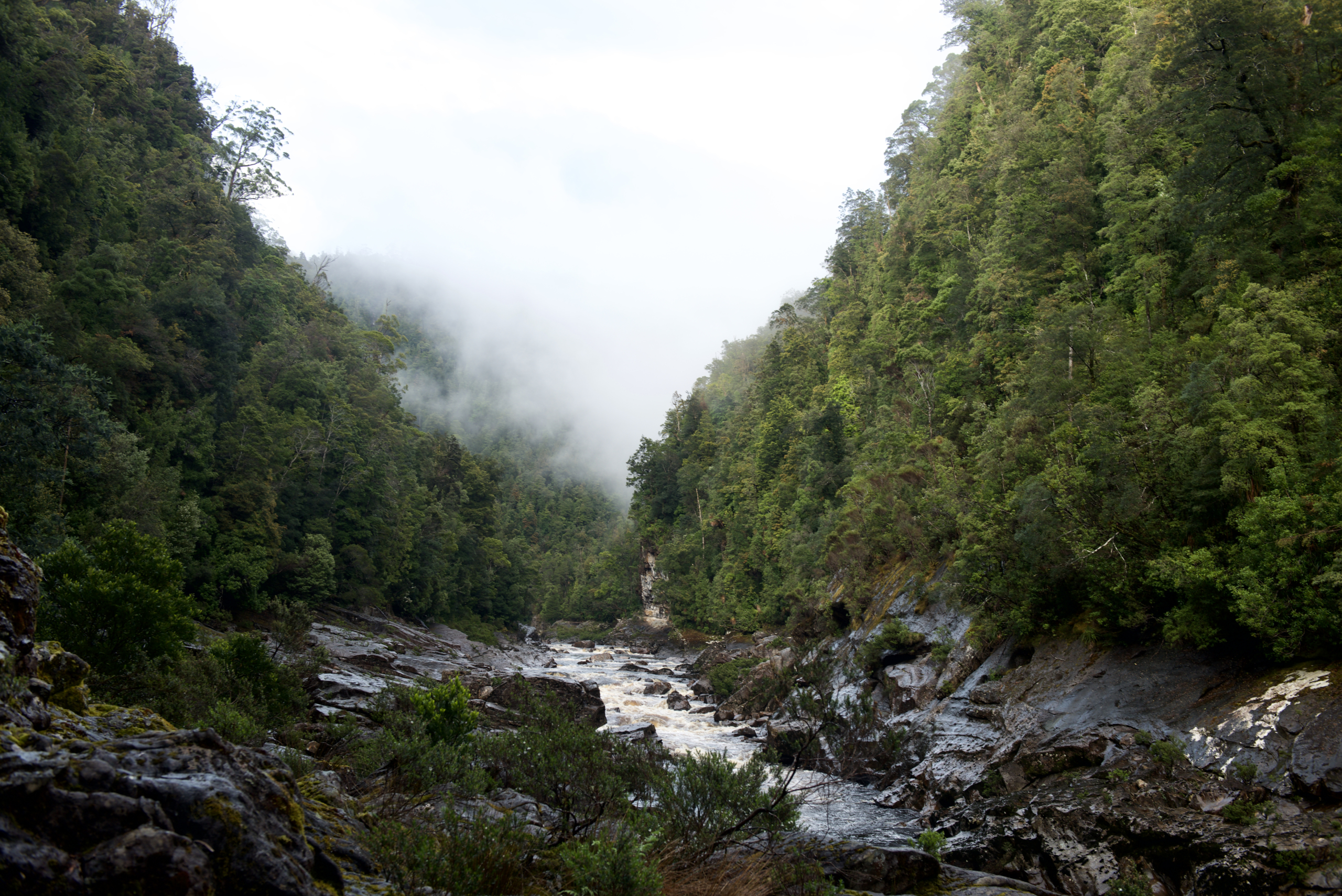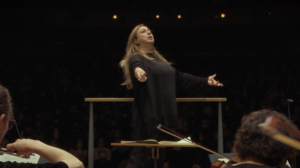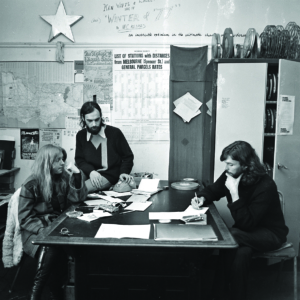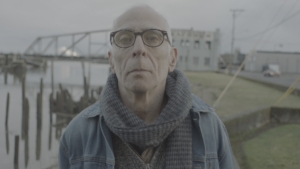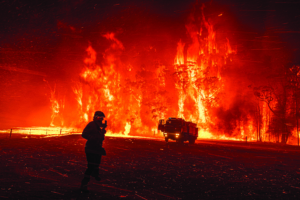As its title suggests, at the heart of Franklin (Kasimir Burgess, 2022) is the major perennial river of the same name that extends 129 kilometres through the mountainous, wet, forested expanses of the central highlands and western regions of Tasmania. In this documentary, the Franklin River functions as a stage across which two interconnected stories are told, linking past and present: the first is the story of the struggle to save the river from hydro-electric development in the late 1970s and early 1980s, to this day the nation’s most consequential environmental campaign;[1]The campaign has been well documented in Australian archives, including by the National Museum of Australia; see ‘Franklin Dam and the Greens’, National Museum of Australia website, updated 13 July 2022, <https://www.nma.gov.au/defining-moments/resources/franklin-dam-and-the-greens>, accessed 25 August 2022. and the second is the story of narrator Oliver Cassidy, whose late father, Michael, was deeply involved in the movement.
In January 1983, just before Cassidy was born, his father embarked on a rafting trip down the Franklin to join the blockade; and, several years after Michael’s death, Cassidy retraces this expedition. Requiring a rubber raft, the eighteen-day journey is arduous and dangerous; it is, nevertheless, the only way to experience the remarkable river wilderness. Scenes of the journey in the documentary reveal this remote, rainy and sublimely beautiful river region, with the physical difficulty of the trip asserting its status as a rite of passage.
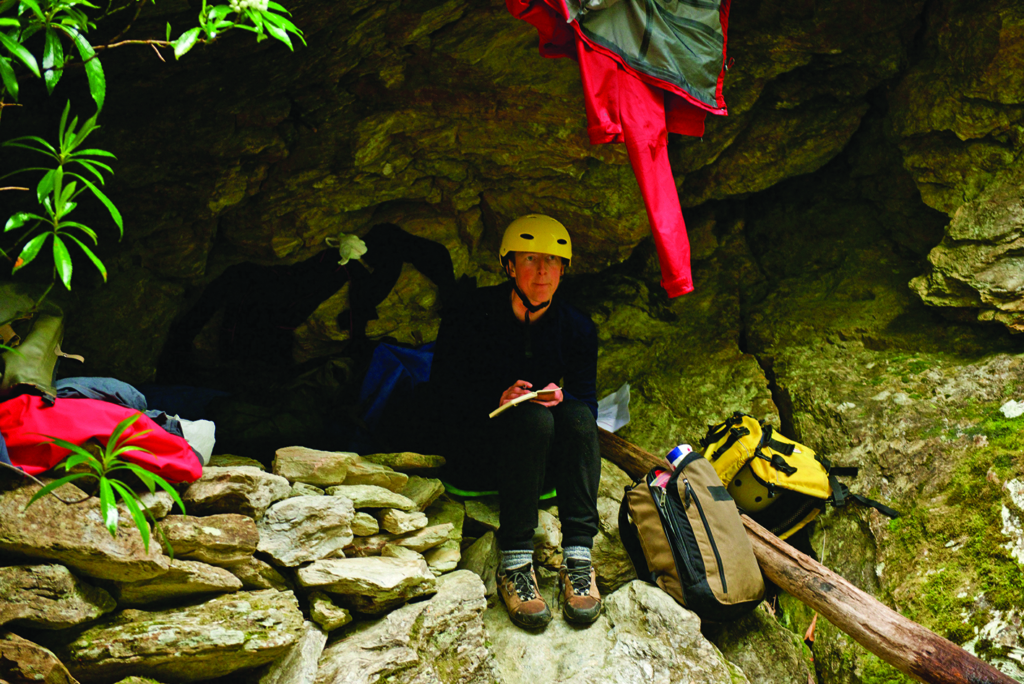
The voiceover consists of a ghostly dialogue between Cassidy and passages from his father’s diary (spoken by Hugo Weaving). This is an intimate story heightened by gradual insights into Cassidy’s transgender identity, including the fact that he underwent gender-affirming surgery shortly before the trip. This dimension of Franklin is anchored in Cassidy’s compelling personal history and his present-day embodied experience on the river.
These almost mystical scenes on the river are interspersed with another story about the Franklin – the unprecedented eight-year struggle to save it from being lost to inundation as a result of the construction of a series of dams by the state-owned Hydro-Electric Commission (HEC). This part of the film is conveyed via an impressive catalogue of archival material drawn from films, photography and news reports as well as recent interviews, largely with those who took part in the campaign. The memories of those interviewed bring alive the events and strategies used in the protests, including the blockade of the lower Gordon River in the summer of 1982/83. Central to the documentary is an interview with former Australian Greens leader Bob Brown, who was a key figure in the campaign from the beginning, but his is just one of many voices called on to relate details of the time and build an intricate picture of what occurred. Franklin tells this story chronologically, showing how the struggle went from a small-scale but highly strategic campaign instigated by the newly formed Tasmanian Wilderness Society to an issue of national import that resulted in the biggest show of civil disobedience in Australia’s history – one that has been credited with, among other things, changing the course of the 1983 federal election.[2]See ‘Protest Against the Damming of the Franklin River’, National Archives of Australia website, 2010, <https://www.naa.gov.au/learn/learning-resources/learning-resource-themes/government-and-democracy/activism/protest-against-damming-franklin-river>, accessed 25 August 2022.
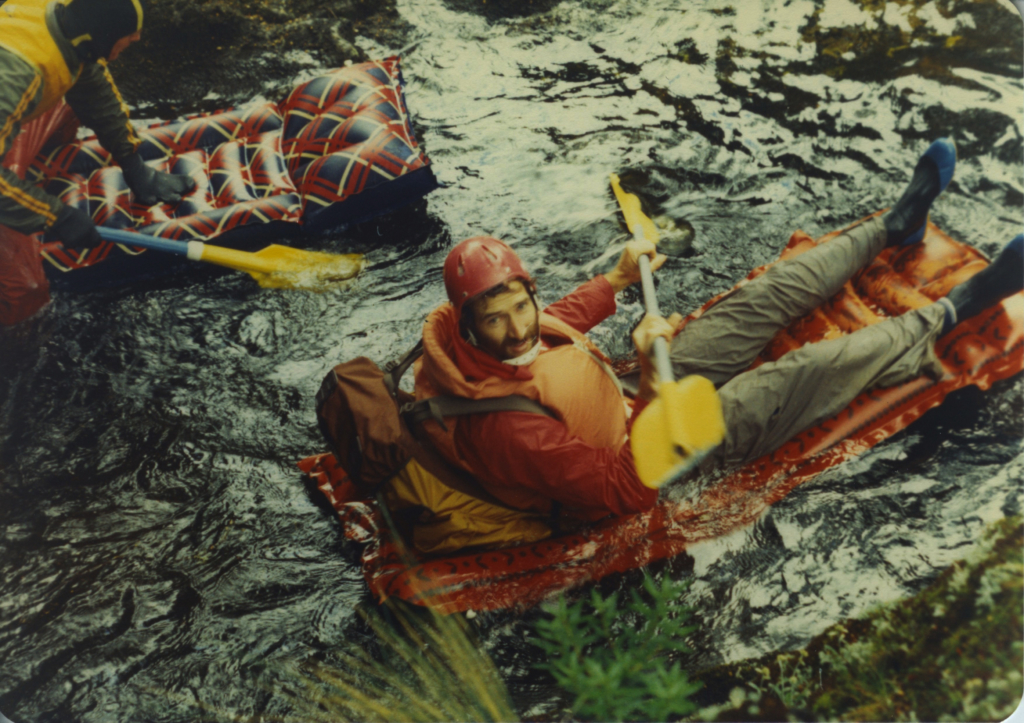
This recounting in sound and image takes the viewer through several emotional registers as events unfold. Franklin brings clearly into view the lines that separated the interests of the state and its supporters from those of the protesters (often referred to derisively as ‘greenies’). Footage of the blockade is particularly affecting, with the malevolence directed at the demonstrators palpable; at one point, a barge carrying police and construction workers ploughs through rubber rafts holding peaceful protesters. The pitched battle is, in the short term, lost. The devastation on activists’ faces as forestry workers bring their chainsaws to old-growth forests lingers long after the film’s conclusion.
This recounting in sound and image takes the viewer through several emotional registers as events unfold … The devastation on activists’ faces as forestry workers bring their chainsaws to old-growth forests lingers long after the film’s conclusion.
In a subtle way, Franklin testifies to the presence of filmmakers in the campaign every step of the way. The footage they shot plays a crucial role in relaying this history, whether it was filmed within the blockade and protesters’ camps or on the early rafting trips that brought the river vistas into the public imagination in moving-image form. Producer Chris Kamen and director Burgess undertook a painstaking process of locating films and unused rushes that could be included to help tell the story of the campaign and the river, and the material they have sourced constitutes an important part of Australia’s audiovisual heritage.
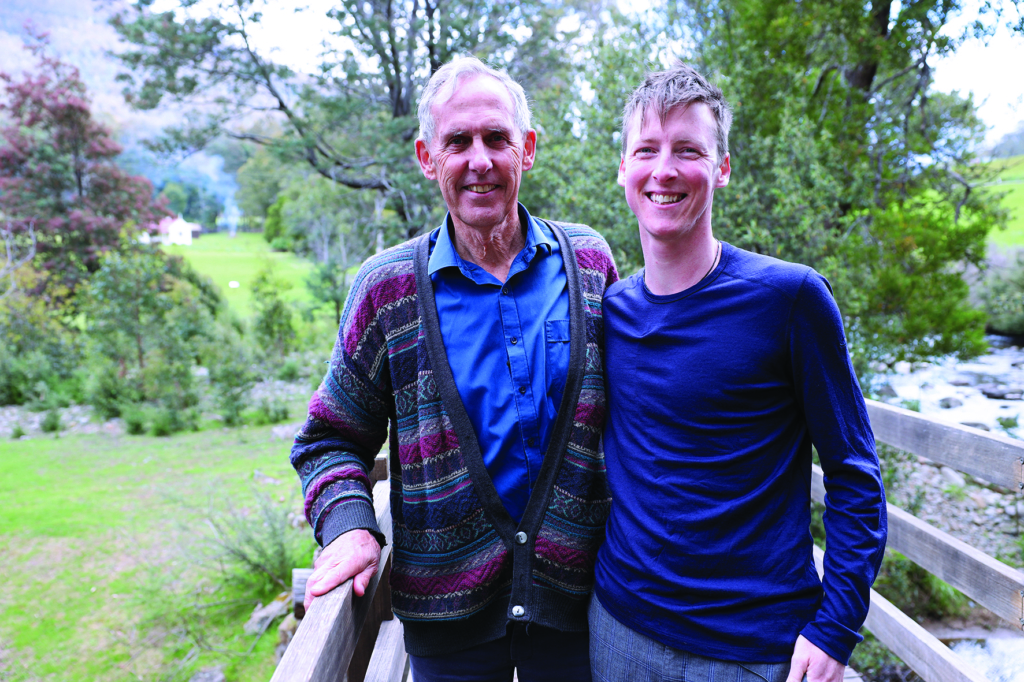
Particularly compelling is the place Franklin occupies in a lineage of films that turned the Franklin River rafting experience into a story for the purpose of conservation advocacy. Indeed, it was a short film – the first to be shot on the river – that was the earliest concerted effort in the campaign. The Last Wild River (Paul Smith,[3]While The Last Wild River’s direction is generally ascribed to Smith, no director is listed in the film’s credits. Otherwise, aspects of the production were a collective endeavour, with contributions from Smith, Amanda Stark and others. 1977), often only referred to in passing in accounts of the Franklin campaign, was crucial. Smith’s idea was to travel down the river on a rubber raft, which enabled the use of a Bolex camera; Launceston Walking Club members Brown, Amanda Stark, Rick Rolls and Peter Thompson accompanied him to play the roles of rafters on a summer expedition. This 28-minute 16mm film was the first to realise the filmic storytelling potential of river rafting journeys. Stark, also a founding member of the Tasmanian Wilderness Society, describes the film to me as ‘very useful, as it was the catalyst for the whole Franklin River campaign’. Scenes from The Last Wild River feature prominently in Burgess’ documentary, and Brown reflects on it in his present-day interview, describing the 1978 film’s significance and the achievement of securing a prime-time television broadcast on a Saturday night.
Indeed, through its distribution and impact, The Last Wild River offers an exemplar of early campaign filmmaking. The film not only toured around Tasmania but was also brought to different parts of Australia, with community screenings held in town halls and churches in a bid to highlight the threat to the river and what would be lost if the dam were built. Co-founder of the Melbourne branch of the Tasmanian Wilderness Society Karen Alexander, who was involved in circulating the 1978 film, describes how Victorian screenings were advertised to every relevant group they could think of, including environmental organisations (such as Friends of the Earth), field naturalists, bushwalking clubs, the Youth Hostels Association, schools, local media and libraries. The Last Wild River was the first film to reimagine this part of Tasmania for an audience beyond the walkers or climbers already familiar with the area; importantly, it worked to motivate the audience not through a didactic message about the HEC, but rather by shaping how people saw the river and its potential for recreation and adventure. Bookended by the beginning and end of the river journey, The Last Wild River takes the form of a travel film told from the perspective of the rafters. It is significant that the filmmakers decided to feature the rafting trip centrally in the narrative when they might have simply crafted the film out of spectacular footage of the river and erased any visible human presence. Instead, it invites identification with the rafter, and constructs the wild river as an embodied experience – an ideal wilderness adventure.
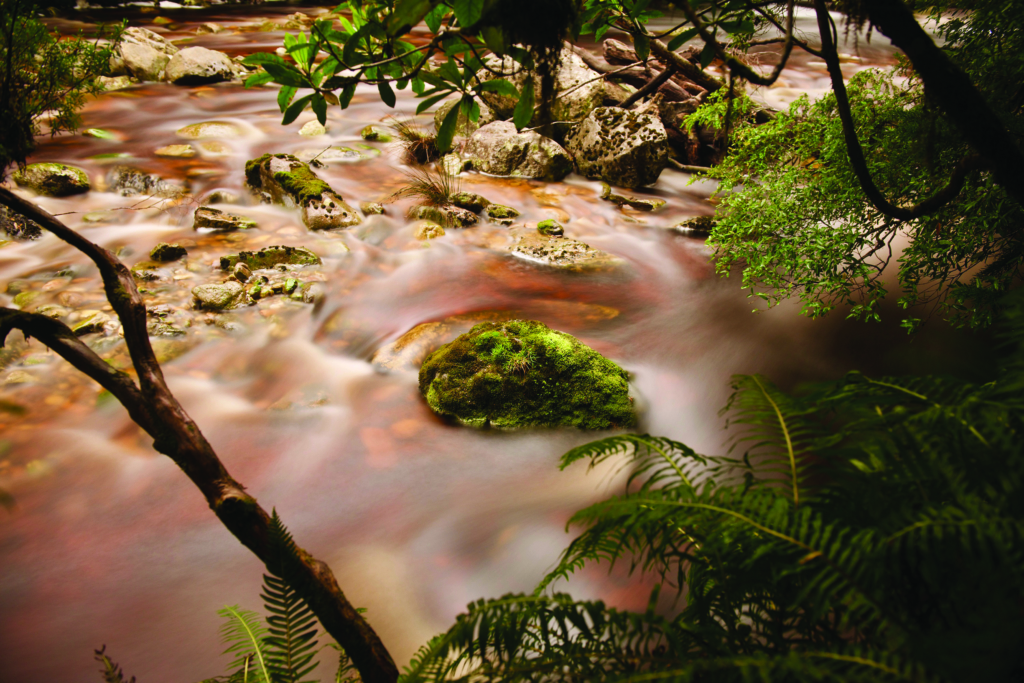
The visual lexicon of the wild river journey made its way into subsequent films that were made in support of the campaign, including Tasmania’s South West: A Wilderness in Question (Damon Smith, 1979), The Franklin: Wild River (Michael Cordell, Stacey Gavrily & Chris Noone, 1980), Franklin River Journey (Bob Connolly, 1980), Gordon Splits (Cordell, 1982), The Franklin Adventure (Joe Connor, 1983) and Huon Cry (Philip Lohrey, 1983). Several of those involved in producing these films, such as Connolly, Cordell, Connor and Rolf de Heer (who co-produced Damon Smith’s film), either were or later became accomplished figures in the Australian film industry. The early 1980s was not only a pivotal time in the Australian environmental movement but also a germinal time for the contemporary film and television industry, and this body of films marks a fascinating intersection of the two.
By crafting a detailed account of the campaign, the film shows not just what is possible but how it is possible. While archival recordings of large street rallies are standout moments, they are shown to have been part of a whole campaign architecture that developed over years.
Burgess refers to the early Franklin films as having a ‘painterly’ feel, with washed-out tones. He notes, ‘Those films are beautiful, but they feel like a faded, distant memory. I couldn’t think of recent footage of the film that really celebrated it.’ Franklin brings the river to a new audience, but through a different aesthetic lens, with Burgess returning to the Franklin with drones, GoPros and a high-resolution Arri Alexa LF camera. The Last Wild River is light and warm despite the arduous nature of the trip it depicts, and the group are seen variously paddling through serene, secluded parts of the river and turbulent rapids in the bright summer sun. Burgess’ documentary, in contrast, shows the river in lucid tones: the more unforgiving aspects of the landscape, including the frequent rain, are much more apparent. Franklin’s high-resolution images thus both rise to the expectations of contemporary audiences and tell a different story about the river. Describing the structure of film and its dual narrative threads, Burgess tells me that the aim was to ensure that Cassidy’s personal story could ‘flow into the history, for one to serve the other’. He describes one of the main challenges being ‘to find a way to let the stories all sing together’.
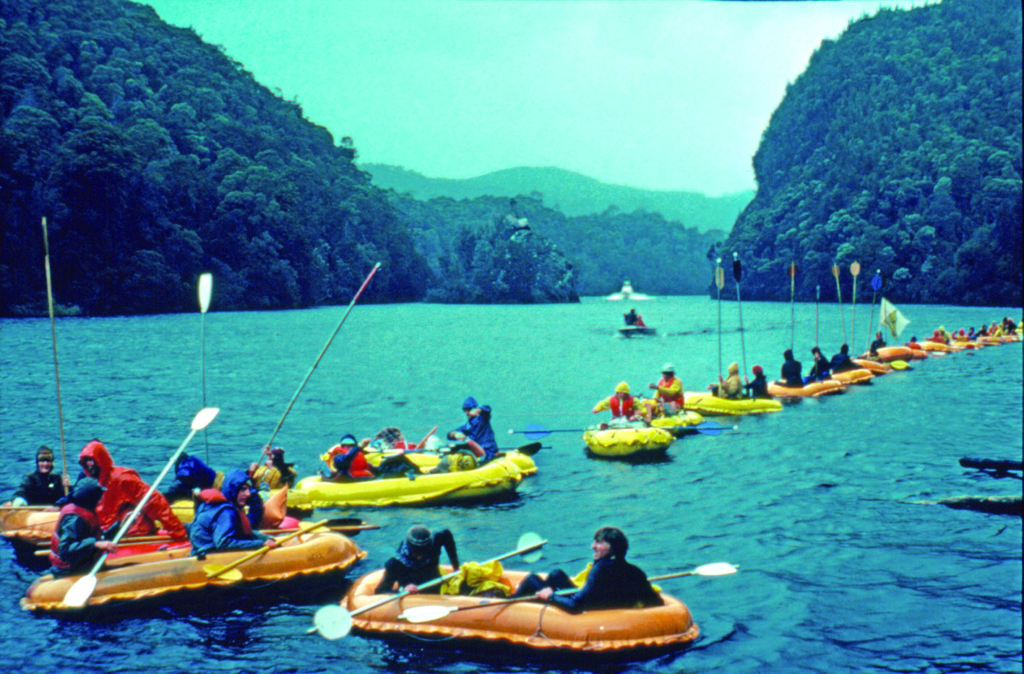
This narrative structure serves the film’s broader purpose. Supported in part through crowdfunding, Franklin is concerned as much with portraying a historical moment in environmental politics as with energising future environmental action. As Cassidy puts it, ‘There is power in showing what happened and celebrating that but also in looking at protest in general and what it takes to make a movement.’ By crafting a detailed account of the campaign, the film shows not just what is possible but how it is possible. While archival recordings of large street rallies are standout moments, they are shown to have been part of a whole campaign architecture that developed over years. For Cassidy, one aim of Franklin is
[to] empower people with the knowledge that, yes, while doing placards on the street is important, it may not get the message to the person you want, but it’s a great tool for building community and resilience for the next thing that has to happen.
Another striking aspect of the film is its representation of the range of tactics used at the time, especially regarding image production. Filmmaking was one pillar, but there was also a powerful deployment of wilderness photography and choreographed blockade scenes for the media; all were produced through an interplay of what was needed and what was offered by specific characteristics of the river system.
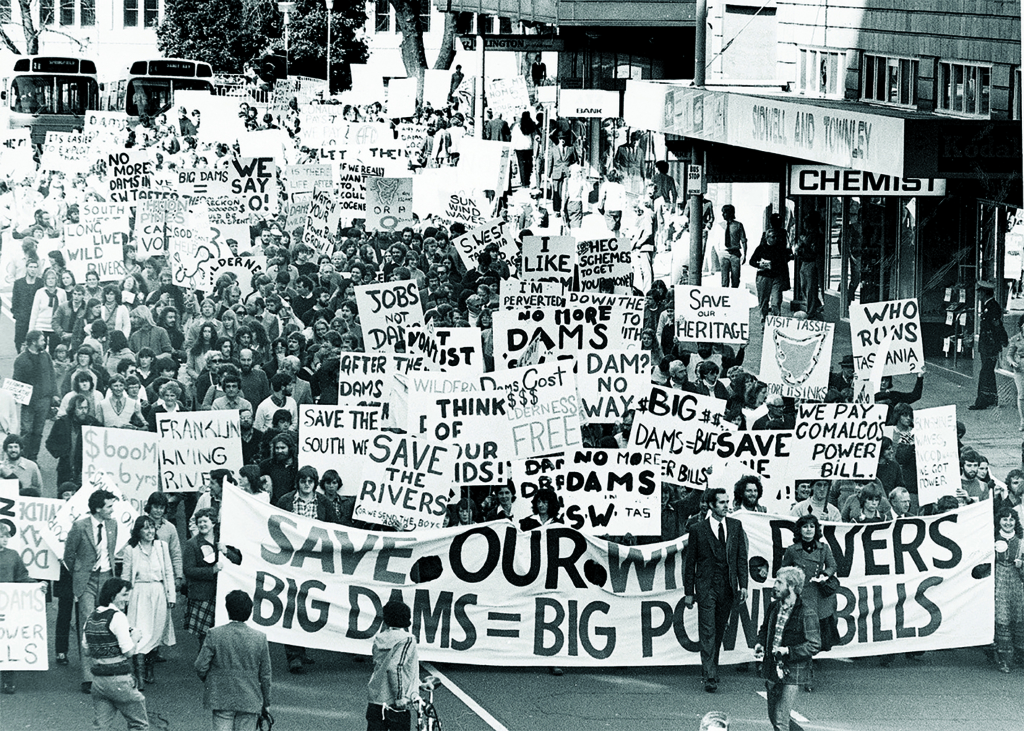
Franklin also casts light on the fact that the campaign was composed of a coalition of different groups. Perhaps most striking is the emphasis on the participation of Aboriginal activists, who were among the thousands arrested at the blockade. Cassidy’s expedition on the river, moreover, reveals the landscape’s multiple dimensions – not just a lush, tempestuous wilderness or a destination for adventure rafting, it also houses sites of spiritual and archaeological importance that mark this place as country cared for by its traditional owners over millennia. Uncle Jim Everett and Aunty Patsy Cameron, who also worked as consultants on the production, appear in the film to give voice to the long cultural heritage that extends back to the Ice Age and reflect on the lack of understanding that has driven colonial exploitation of the land. In this way, Franklin brings attention to an aspect of the campaign that has not been frequently discussed in accounts of this moment. This is a multidimensional film, with many elements flowing together and interconnecting.
Another critical aspect of the story relates to Cassidy’s voice and embodied presence in Franklin as a transgender man. Production coincided with his process of transitioning, a fact that Cassidy struggled with early in the filmmaking process because he felt it could ‘potentially commit an already complex film to being an unfundable Gordian knot’.[4]Oliver Cassidy, ‘Creative Statement by Oliver Cassidy’, Franklin press kit, 2022, p. 10. This was ultimately not the case, however. Although early versions of the script offered a detailed story of the arc of his transition, the final film provides a more nuanced treatment. The river journey and Cassidy’s relationship with his father are instead prioritised, with a gradual elaboration of Cassidy’s trans experience – or, at least, parts of it – conveyed later in the film in voiceover and image. He tells me that decisions made in the final edit of Franklin were motivated by an endeavour
to do a service for me and other people in the world who didn’t need to hear the same version of trans stories that we hear all the time, but [to just tell] human stories that happen to have trans bodies involved.
There are many different voices in Franklin, but Cassidy is the overriding point of identification in the film, and his story brings the relevance of the campaign alive in a personal way.
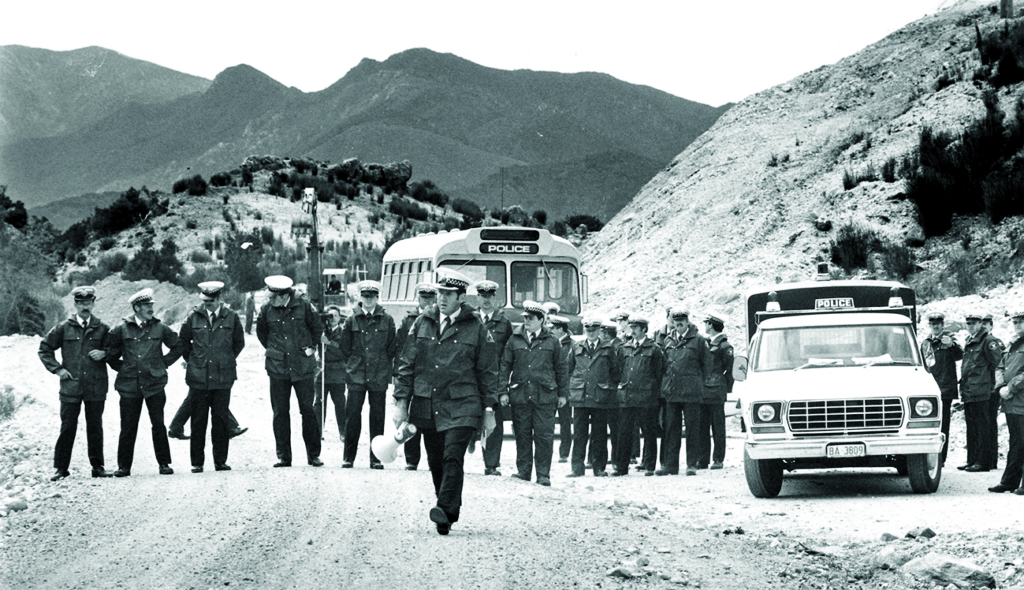
The release of this film is timely. Activism and peaceful public protest play a crucial role in contemporary democracy, and strengthen the relationship between citizens and the state. Recent laws passed in Victoria, New South Wales and Tasmania have put that in jeopardy.[5]See Kieran Pender, ‘Anti-protest Laws Are an Affront to Democracy. They Have No Place in Australia’, The Guardian, 22 June 2022, <https://www.theguardian.com/commentisfree/2022/jun/22/anti-protest-laws-are-an-affront-to-democracy-they-have-no-place-in-australia>, accessed 25 August 2022. The stakes for the environment have never been higher, encompassing not only climate change and the devastation of floods and bushfires but also the crisis of species loss occurring across Australia, which has one of the highest rates of mammal extinction in the world. Much has changed since the Franklin campaign, including the parliamentary emergence of the Australian Greens and the new organising possibilities of social media and digital image-making. Cassidy believes there is still a robust place for campaign organising, and that ‘a lot of things have changed in terms of the tools, but the theory and the structure you need to have in place are the same bones’. Franklin offers stories of resilience and personal action. As an exemplar of environmental action, the documentary mobilises the potential of contemporary filmmaking to inspire a new audience.
Endnotes
| 1 | The campaign has been well documented in Australian archives, including by the National Museum of Australia; see ‘Franklin Dam and the Greens’, National Museum of Australia website, updated 13 July 2022, <https://www.nma.gov.au/defining-moments/resources/franklin-dam-and-the-greens>, accessed 25 August 2022. |
|---|---|
| 2 | See ‘Protest Against the Damming of the Franklin River’, National Archives of Australia website, 2010, <https://www.naa.gov.au/learn/learning-resources/learning-resource-themes/government-and-democracy/activism/protest-against-damming-franklin-river>, accessed 25 August 2022. |
| 3 | While The Last Wild River’s direction is generally ascribed to Smith, no director is listed in the film’s credits. Otherwise, aspects of the production were a collective endeavour, with contributions from Smith, Amanda Stark and others. |
| 4 | Oliver Cassidy, ‘Creative Statement by Oliver Cassidy’, Franklin press kit, 2022, p. 10. |
| 5 | See Kieran Pender, ‘Anti-protest Laws Are an Affront to Democracy. They Have No Place in Australia’, The Guardian, 22 June 2022, <https://www.theguardian.com/commentisfree/2022/jun/22/anti-protest-laws-are-an-affront-to-democracy-they-have-no-place-in-australia>, accessed 25 August 2022. |
